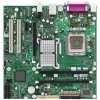Intel BLKD946GZISSL Product Specification - Page 30
Legacy I/O Controller
 |
UPC - 735858183550
View all Intel BLKD946GZISSL manuals
Add to My Manuals
Save this manual to your list of manuals |
Page 30 highlights
Intel Desktop Board D946GZIS Technical Product Specification 1.6 Legacy I/O Controller The I/O controller provides the following features: • One serial port • One parallel port with Extended Capabilities Port (ECP) and Enhanced Parallel Port (EPP) support • Serial IRQ interface compatible with serialized IRQ support for PCI systems • PS/2-style mouse and keyboard interfaces • Interface for one 1.44 MB or 2.88 MB diskette drive • Intelligent power management, including a programmable wake-up event interface • PCI power management support The BIOS Setup program provides configuration options for the I/O controller. 1.6.1 Serial Port The board has one serial port connector located on the back panel. The serial port supports data transfers at speeds up to 115.2 kbits/sec with BIOS support. For information about The location of the serial port connector Refer to Figure 13, page 51 1.6.2 Parallel Port The 25-pin D-Sub parallel port connector is located on the back panel. Use the BIOS Setup program to set the parallel port mode. For information about The location of the parallel port connector Refer to Figure 13, page 51 1.6.3 Diskette Drive Controller The I/O controller supports one diskette drive. Use the BIOS Setup program to configure the diskette drive interface. For information about The location of the diskette drive connector Refer to Figure 14, page 52 1.6.4 Keyboard and Mouse Interface The PS/2 keyboard and mouse connectors are located on the back panel. NOTE The keyboard is supported in the bottom PS/2 connector and the mouse is supported in the top PS/2 connector. Power to the computer should be turned off before a keyboard or mouse is connected or disconnected. For information about The location of the keyboard and mouse connectors Refer to Figure 13, page 51 30















